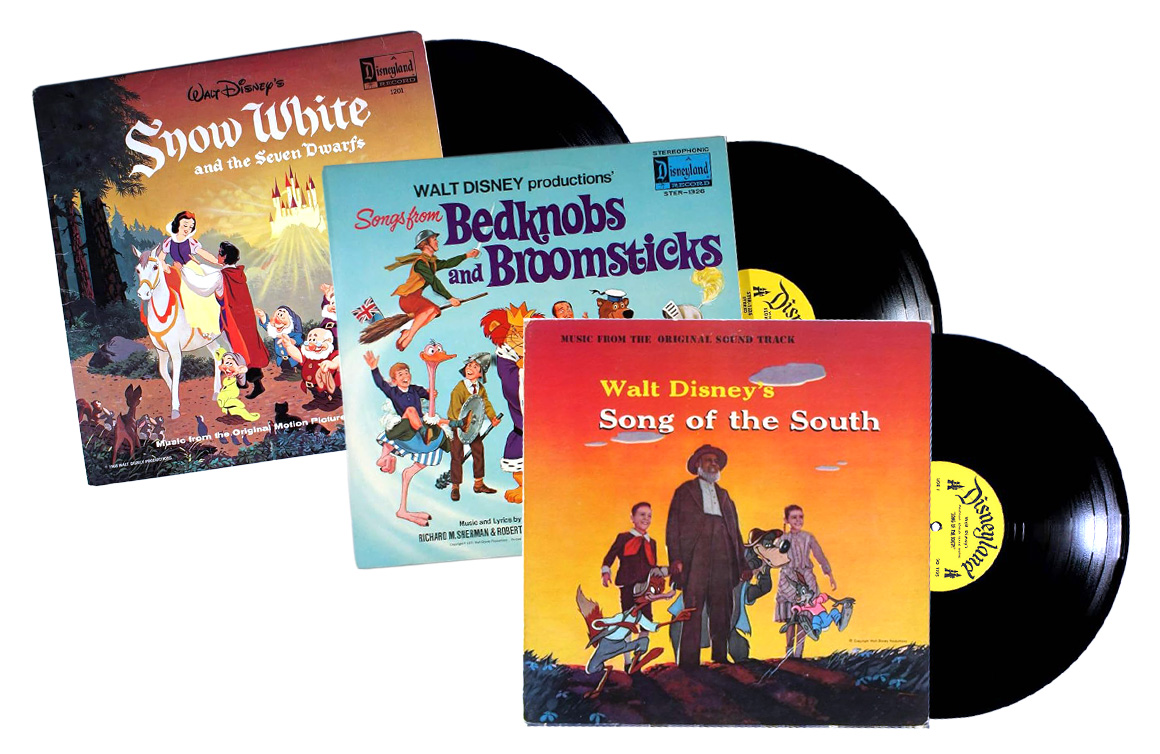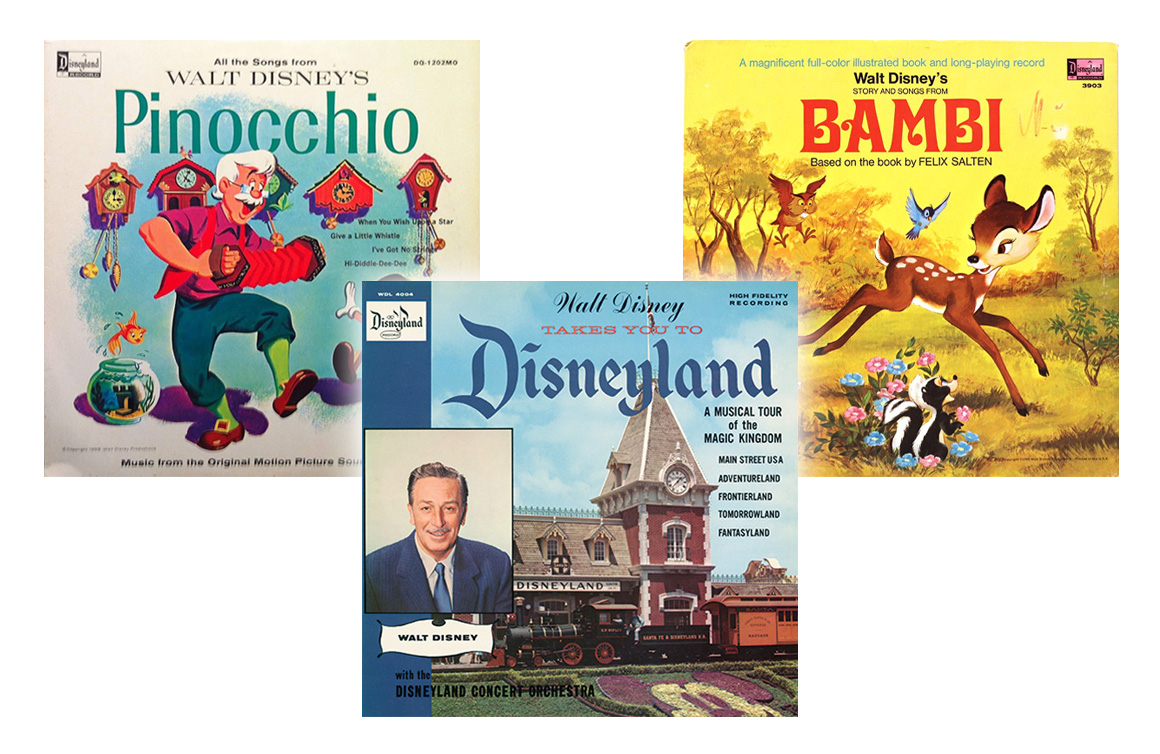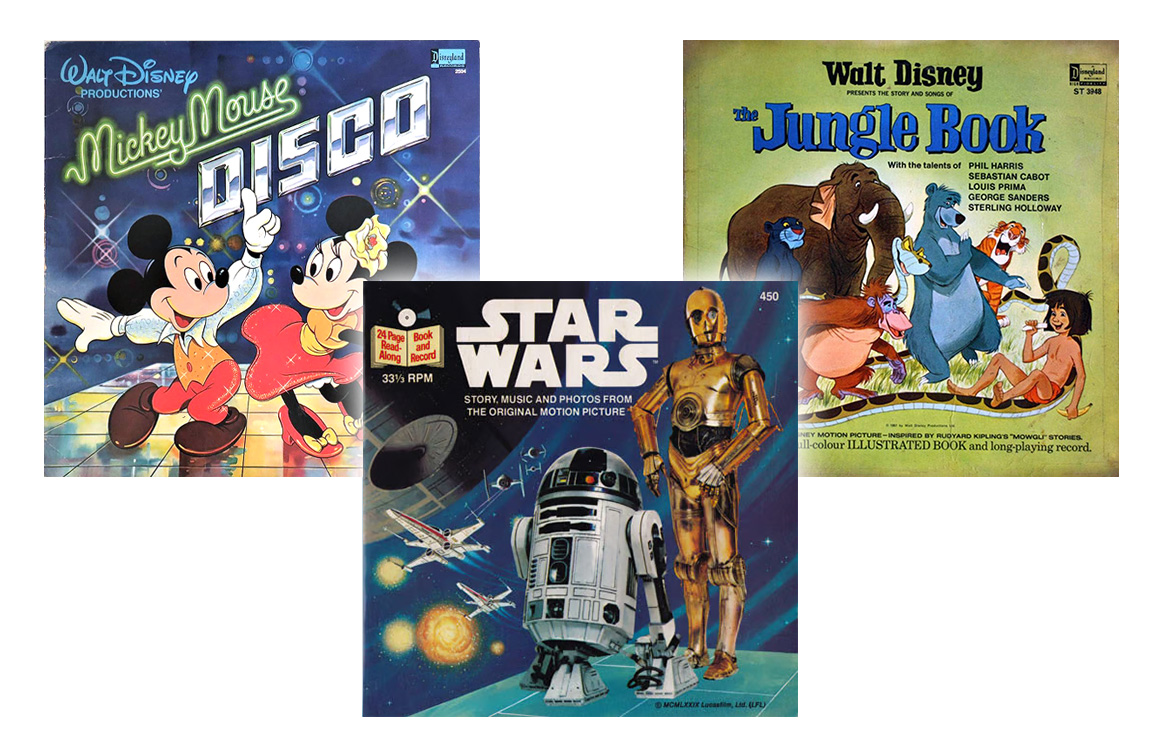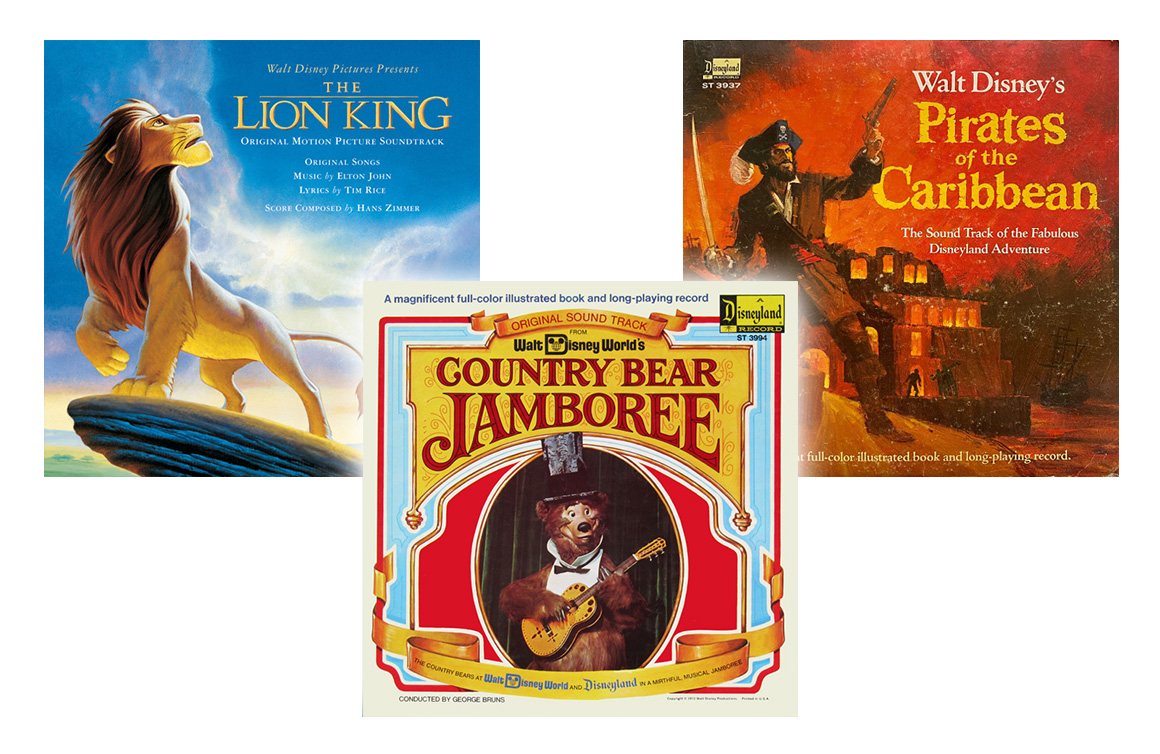Walt Disney has been synonymous with wholesome entertainment for countless generations, including animated and live-action films, theme parks, television programs, and merchandise. No record collection is complete without a Disney record, regardless of the format.
Disneyland Records started from humble beginnings, like earlier labels such as Peter Pan Records and Golden Records. Before establishing its label, it partnered with established music companies to distribute its songs to the public. This allowed the studio to reach a wider audience while focusing on its central business of animation and storytelling.
MUSICAL MILESTONES
In the early 1920s, Walt Disney Productions focused on silent cartoons before transitioning to sound. The studio introduced synchronized sound with Steamboat Willie (1928), featuring the iconic character of Mickey Mouse.
Following that success, Disney released the animated short The Three Little Pigs (1933). Here began the studio’s foray into the music industry. The song from the film Who’s Afraid of the Big Bad Wolf? became a commercial hit. The following year, RCA Victor released the song, performed by Frank Luther and his Orchestra, on 78 RPM picture discs with colourful illustrations.
As the company’s film output grew, so did its presence in the music industry. Labels like Decca, Capitol, and Columbia began releasing soundtracks and singles tied to Disney’s animated features. Notably, Snow White and the Seven Dwarfs (1937) was one of the first film soundtracks to be officially released, further cementing Disney’s relationship with the music business.
One notable milestone before the establishment of the label was The Ballad of Davy Crockett, featured in the Disneyland anthology television series and released by Cadence Records in 1955. Performed by Bill Hayes, the song achieved nationwide popularity, selling millions of copies and exceeding the sales of the version sung by series star Fess Parker, which Columbia released that same year. Additionally, materials related to the Mickey Mouse Club from Golden and ABC Records sold millions of copies, illustrating the commercial success of Disney-related music and suggesting the potential need for a dedicated music label.
INTRODUCING DISNEYLAND RECORDS
By the mid-’50s, consumer products marketer Jimmy Johnson believed that Disney could manage an in-house record label instead of using outside labels to distribute songs. But first, he needed to persuade the studio’s financial chief — and Walt’s brother — Roy O. Disney, who preferred to stay with existing partnerships and viewed the music industry as risky. Johnson persisted, and eventually Roy agreed. On February 4, 1956, Disneyland Records was officially founded, with Johnson as its first president. For the Artists and Repertoire (A&R) department, Johnson recruited esteemed producer Salvador “Tutti” Camarata, and together they produced a catalogue that included film soundtracks, original recordings, story albums, and theme park audio experiences.
Although the new imprint produced its first record — a musical version of A Child’s Garden of Verses — a few months earlier, the Charles Hansen music publishing company initially distributed the 10-inch LP. The inaugural official Disneyland album was titled Walt Disney Takes You to Disneyland. This album featured Walt himself guiding listeners through a tour of the park’s attractions. The label also released this album alongside various film soundtracks, including Song of the South, Pinocchio, Bambi, and Snow White.
During its initial years, Disneyland Records primarily released soundtracks and story albums associated with Disney films and theme parks. In 1957, the song Wringle Wrangle, performed by Fess Parker for the film Westward Ho the Wagons!, achieved commercial success, thus demonstrating the potential for the label to explore recordings beyond film-related content. Therefore, Disneyland began producing and releasing music outside its traditional scope.
Despite efforts to appeal to adult consumers, the industry broadly classified all Disney-related content as children’s music. Although most Disneyland albums were family-oriented, a notable exception was Camarata’s album Tutti’s Trumpets, an instrumental jazz-inspired recording that achieved success beyond the children’s category. With that in mind, Disney made a strategic decision in 1959 and founded a new imprint, Buena Vista Records, to manage pop and adult-oriented music. Buena Vista subsequently released significant works by Annette Funicello and Louis Prima, and early film scores were not directly associated with animated features. Disneyland Records now officially focused on soundtracks and children’s albums.
DIVERSIFICATION
As Disneyland expanded its scope, Camarata sought songwriting talent to create original music for Disney’s young star, Annette Funicello. This search eventually led him to Richard M. Sherman and Robert B. Sherman, a songwriting duo whose work he heard on the radio. Recognizing their melodic abilities, Camarata facilitated the Sherman Brothers’ introduction to the Disney studio in Burbank, where they became the company’s first staff songwriters.
The Sherman Brothers’ influence on Disney music exceeded that of Annette’s songs. They created iconic tracks like It’s a Small World and The Tiki Tiki Tiki Room for theme parks, as well as memorable compositions for Mary Poppins, Winnie the Pooh, The Jungle Book, and Bedknobs and Broomsticks. Their work defined Disney’s sound in the 1960s and beyond, making them two of the company’s most influential songwriters.
In 1960, Camarata left his position as A&R director and set up a full-service recording studio called Sunset Sound, where he and his team produced Disney’s and Buena Vista’s records. He continued to work with the studio until 1971.
1965 saw Disneyland Records become a prominent label for Disney soundtracks and children’s recordings. That year, the company launched its Read-Along series, which combined storybooks with 7-inch LPs, marketed as the “Original Little Long-Playing Records,” to narrate stories with music (Johnson was not a fan of the 45s, as he felt they limited the depth of the recordings). This format enabled children to follow along with their books while listening to the records, making reading more interactive.
At the core of the Read-Along series was Robie Lester, whose warm and expressive narration became a hallmark of these recordings. Lester lent her voice to numerous Disney stories, guiding listeners with the notable phrase: “You will know it is time to turn the page when Tinker Bell rings her little bells like this…” Her contributions firmly established the series as an esteemed part of Disney’s musical heritage.
Throughout the 1970s, Disneyland expanded its catalogue by releasing new albums, read-along titles, and Storyteller LPs. In 1979, two significant events influenced the direction of the label. The first was the release of Mickey Mouse Disco, which arrived just as the disco craze was starting to fade. Initially, sales were modest, but Disney took a creative approach to marketing the album. Instead of relying solely on traditional retail, the company promoted Mickey Mouse Disco on television as a mail-order product, mirroring strategies used by popular album companies like Ronco and K-Tel. The campaign worked — months later, the album went gold, and within a few years, it became the first children’s album to achieve double platinum status.
The second significant event stemmed from the overwhelming popularity of Star Wars following its 1977 theatrical debut. Seeing an opportunity to tap into the franchise’s success, Disneyland secured a license to produce a 7-inch LP read-along under the Buena Vista brand. This release began a broader expansion, as the Buena Vista Adventure Series brought several major movie titles — including entries from the Star Wars saga — to the read-along format, integrating still photos and music from the original motion picture soundtracks.
By the early 1980s, Disneyland Records had become the leading label for Disney soundtracks, read-along albums, and children’s music. As Disney’s entertainment portfolio expanded, the label was rebranded to Disneyland/Vista Records and Tapes to better represent its growing catalog. Disneyland continued to manage animated film soundtracks and family-oriented albums, while Buena Vista Records specialized in pop music, live-action films, and broader commercial releases.
Moreover, albums related to theme parks achieved further success, as the label issued soundtracks from renowned attractions such as The Haunted Mansion, Pirates of the Caribbean, and The Country Bear Jamboree. These releases enabled fans to enjoy an aspect of the Disney Parks experience at home, thereby reinforcing the distinctive identity of Disneyland Records.
MODERNIZATION
Around the late 1980s, Disney sought to modernize and streamline its music division. As the company’s branding continued to evolve, the Disneyland name became less relevant to a global audience increasingly familiar with Walt Disney-branded entertainment. In 1988, the label officially rebranded as Walt Disney Records, marking the end of the Disneyland Records era. This transition established a foundation for musical expansion, allowing the label to produce music for both animated and live-action films, explore new genres, and form partnerships that would shape Disney’s future in the industry.
As CDs became the dominant format in the late ’80s and ’90s, Walt Disney Records reissued classic soundtracks and produced new releases of digital quality. One notable success was The Lion King soundtrack in 1994, featuring songs by Elton John and Tim Rice. The album received multiple platinum certifications and an Academy Award for Can You Feel the Love Tonight.
In 2006, Walt Disney Records was merged into the newly established Disney Music Group, integrating operations with Hollywood Records and Buena Vista Records. This reorganization enabled Disney’s music division to broaden its scope beyond traditional soundtracks, encompassing pop music, live-action film scores, and innovative distribution models.
Despite the dominance of CDs and streaming, vinyl records made a surprising comeback in the 2010s. The 2013 Frozen soundtrack helped revive interest in Disney vinyl, prompting the company to reissue classic soundtracks in premium formats for collectors and audiophiles.
With the emergence of streaming platforms such as Spotify, Apple Music, and Disney+, Walt Disney Records adopted digital distribution, making its extensive catalog available to listeners globally.
In response to evolving consumer habits, Disney Music Group has diversified into podcasts, immersive audio projects, and interactive music experiences. These initiatives have enabled Disney to maintain audience engagement innovatively, preserving the relevance and significance of its musical legacy within the dynamic entertainment industry.
And, as they say, now you know the rest of the story. From the early days of Disneyland Records to the advancement of the Disney Music Group, there’s something for everyone. It is a small world, after all.
Now if you’ll excuse me, I’m off to play my collection of Disneyland records, and look forward to celebrating the 70th anniversary next year.





